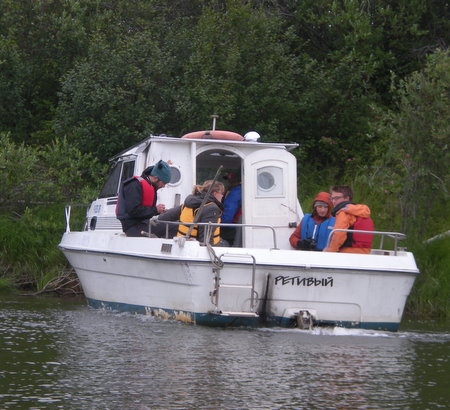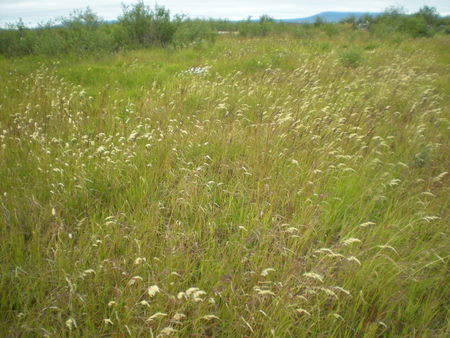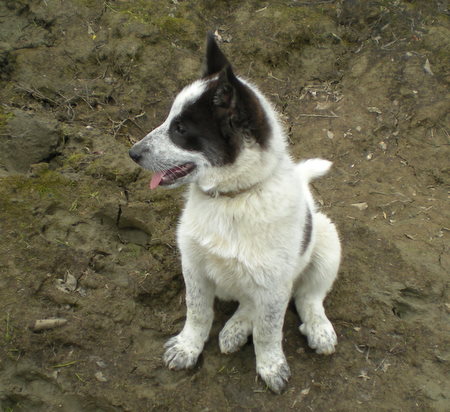Today the group finally got to adventure into the past – the Pleistocene to be specific! After a hearty lunch of moose stew, we embarked in an armada of boats and traveled by river to Pleistocene Park. After hearing and reading so much about this incredible experiment, this was a much anticipated trip for everyone. The boat ride was beautiful, although a little chilly. We wound through a network of rivers and marshlands that gave us a close-up view of the floodplain ecosystem.

At first, the park looks just like the surrounding forests. But as you venture into the heart of the park where the experiment was set-up, the change in ecosystem type is drastic. The forest transitions to grasslands (that make for much more pleasant walking than larch forests). This transition, although remarkable, took time and effort bring about. As Dr. Zimov told us today, the larch forests that currently dominated this region are not native to this part of the world. The mammoth grassland ecosystem that spanned from France to Canada during the Pleistocene was not only a productive ecosystem, but was naturally maintained for thousands of years by large herbivore populations. The transition from the mammoth grasslands to boreal forests only occurred when humans began to wipe out large herbivore populations. When these populations began to decline under hunting pressure, the nutrient recycling and physical disturbance and trampling they provided disappeared, and without it the ecosystem could no longer be supported.

In creating Pleistocene Park, Dr. Zimov hopes to reinstate this ecosystem by reintroducing large herbivore populations. He observed that in areas where wild horses frequently were found, the forest had retreated due to break up of the insulating moss cover and trampling of soil and snow. Since this point, he has introduced wild horses, moose, reindeer, and caribou populations. Although we didn’t see any animals today, their presence was definitely felt. Large portions of land have transitioned from forest to grasslands since their introduction.
This study has particular importance to climate science because these grassland ecosystems may help save the permafrost from degradation. Trampling of snow on grassland ecosystems allows the permafrost layer to freeze deeper every winter, and therefore melt less during summer months. It also has a higher albedo, which reduces the heat being absorbed by the earth. So reintroducing large herbivore populations may be a way to stop permafrost thaw and potential CO2 release.

In addition to being an incredible learning experience, we had a really fun time tromping around the grounds. We met a new friend, a cute puppy ironically named Friend in Russian, and enjoyed the different views of the landscape. The whole group also enjoyed learning from the Russian scientists here, who are a wealth of knowledge on this area’s natural history, and excellent boat drivers.
We can’t believe that our time here is almost up. Our research projects are going really well, but everyone is starting to feel the crunch at the end to finish up. The only thing that could possibly top a trip into the Pleistocene would be a trip to the tundra, and we are hoping to get there tomorrow (weather permitting). More updates soon!
Erin and Blaize!




Comments(8)-
-
-
-
-
-
-
Nancy Cedar says
July 22, 2009 at 11:07 amThanks Erin for validating our time travel theory! The explanation of the grassland ecosystem was fascinating. I realize daily through all your posts how little I know! I still am not sure what exactly a larch and boreal forest is! I am so impressed with all you are doing and learning!
Monique Kantor says
July 22, 2009 at 11:10 amThese blogs keep getting better and better all the time! We know you’re quite busy, but we at home crave them like starved mosquitoes for Hobbits after second breakfast! Erin and Blaize, I really enjoyed your description of Pleistocene Park. When delineated like that, it seems so clear and wise. That’s what good science does, yes?
Max and Travis–thanks for the fly-on-the-wall perspective. It is truly enlightening. It does our hearts good to know there’s such good camraderie on board. Sorry about Wilco. I can’t blame that one on genetically inherited metabolism. You might suggest “Flight of the Conchords” instead. Caution: Nonsensical French Phrases May Fly.
Saw on Chris’ website that he’s taken 15,000 photos so far. That’s incredible.
I hope you make it to the tundra.
Brian–I like how you are capturing the words, thoughts, and spirits of the people there. Theirs are voices we all need to hear.
To all the PIs: thank you for your enthusiasm, patience and guidance.
betsy says
July 22, 2009 at 1:06 pmYour blogs are all incredibly well written. Thanks for taking us to Pleistocene Park. I heard about it last year, but this description really makes it come alive…..as we hope it may continue to do! Thanks all.
Robert Kantor says
July 22, 2009 at 9:36 pmErin and Blaze….absolutely fascinating. The description took me away to another world almost like you must have felt while experiencing this first hand. How long has Dr. Zimov been working on this ecosystem restoration, return to the Pleistocene? The introduction of so many large herbivore varieties must have taken quite a team of people. Who else is providing assistance in his efforts? Is there also a natural progression of carnivore and higher food chain species that become established once herbivores are introduced?
Hope the plans for Tundra became a reality….will be thrilled to hear about that outing.
As for Wilco……not sure if listening to this 5 times per day is worse than listening to Brian singing solo to Wilco while ear plugs are in use while those around him get no Wilco at all. Sort of a “is the glass half full or half empty” scenario.
Sleep well…….keep smiling…you are doing incredible work, all of you.
max says
July 23, 2009 at 12:52 amA few years ago Sergey Zimov wrote a superb article in Science magazine about Pleistocene Park. As you might imagine, the argument that Zimov makes is rather controversial. You can get the article at http://thepolarisproject.org/readings2009/Zimov_et_al_2005_Science.pdf
A longer list of key papers related to the work we’re doing in the Siberian Arctic is here:
http://thepolarisproject.org/field2009.shtml
Monique Kantor says
July 23, 2009 at 7:43 amThank you for the resources, Max. My brief perusal was enticement enough to guarantee a further, more in-depth reading later this evening.
heilkitty says
August 16, 2010 at 4:52 amThanks for the photos. That flora is really amazing.
PS The more correct translation of puppy’s name would be “Buddy”.